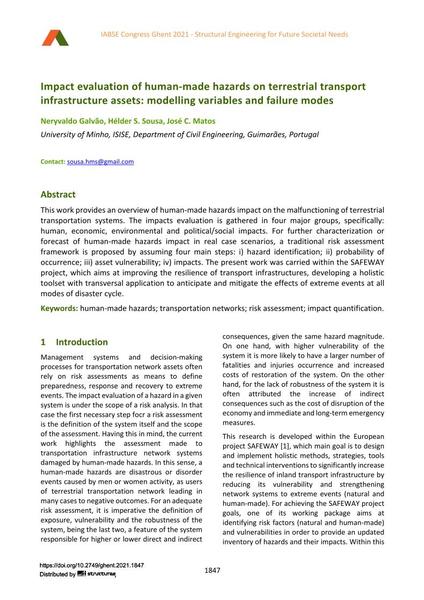Impact evaluation of human-made hazards on terrestrial transport infrastructure assets: modelling variables and failure modes

|
|
|||||||||||
Détails bibliographiques
| Auteur(s): |
Neryvaldo Galvão
(University of Minho, ISISE, Department of Civil Engineering, Guimarães, Portugal)
Hélder S. Sousa José C. Matos |
||||
|---|---|---|---|---|---|
| Médium: | papier de conférence | ||||
| Langue(s): | anglais | ||||
| Conférence: | IABSE Congress: Structural Engineering for Future Societal Needs, Ghent, Belgium, 22-24 September 2021 | ||||
| Publié dans: | IABSE Congress Ghent 2021 | ||||
|
|||||
| Page(s): | 1847-1853 | ||||
| Nombre total de pages (du PDF): | 7 | ||||
| DOI: | 10.2749/ghent.2021.1847 | ||||
| Abstrait: |
This work provides an overview of human-made hazards impact on the malfunctioning of terrestrial transportation systems. The impacts evaluation is gathered in four major groups, specifically: human, economic, environmental and political/social impacts. For further characterization or forecast of human-made hazards impact in real case scenarios, a traditional risk assessment framework is proposed by assuming four main steps: i) hazard identification; ii) probability of occurrence; iii) asset vulnerability; iv) impacts. The present work was carried within the SAFEWAY project, which aims at improving the resilience of transport infrastructures, developing a holistic toolset with transversal application to anticipate and mitigate the effects of extreme events at all modes of disaster cycle. |
||||
| Copyright: | © 2021 International Association for Bridge and Structural Engineering (IABSE) | ||||
| License: | Cette oeuvre ne peut être utilisée sans la permission de l'auteur ou détenteur des droits. |
||||
